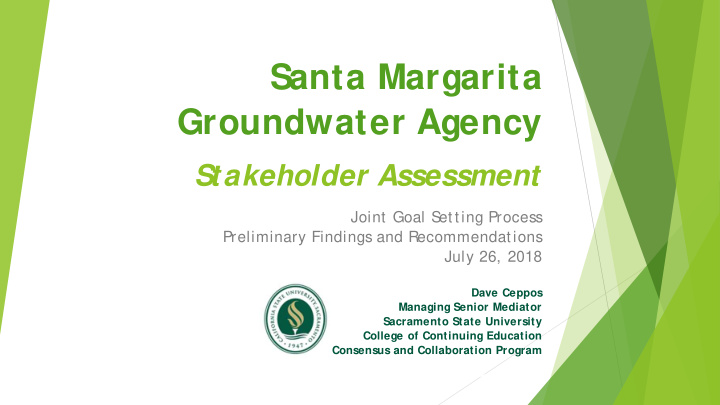



Santa Margarita Groundwater Agency Stakeholder Assessment Joint Goal S et t ing Process Preliminary Findings and Recommendat ions July 26, 2018 Dave Ceppos Managing Senior Mediator Sacramento State University College of Continuing Education Consensus and Collaboration Program
Presentation Outline Assessment Process Summary Findings Draft Recommendations Next Steps
Relationships Historic relationships / effect on groundwater management / trust Cultural / geographic differences / perceived values about water use. Beliefs/ Assumptions vs Facts Agency creation = optimism and potential improved conditions for groundwater conditions, and stakeholder relationships. S GMA is acting as a “ forcing function” in a way past efforts did not. Factors include: New and Partnered leadership Inclusion and support of private groundwater users and related public engagement Heightened awareness of water resource risk as an outcome from the recent drought.
Agency Governance Hist oric relat ionships’ impact on Agency management and concerns about : Leadership, Represent at ion, Meet ing prot ocols/ format and perceived inconsist encies, Part icipant behavior / ‘ safet y These sensit ivit ies are reflect ed in a range of sub t opics including: Fut ure financing of Agency act ivit ies and proj ect “ Ownership” of past act ivit ies and t he impact s said act ivit ies have had on groundwat er condit ions.
Agency Governance (cont.) Current changed conditions impact Agency management including Membership volatility associated with upcoming and future Demographics changes Roles and authorities
Education Agency Education Consistent alignment on current understanding of key groundwater issues Consistent alignment on the need for more groundwater education. Internal Agency education ideas: Basin water budget and water use needs Aquifer complexity and associated impacts on groundwater conditions Groundwater regulation (S GMA) Transparency / The Brown Act / Procedural Requirements General groundwater data Role and authorities of the Agency The needs of the various member water agencies and constituents therein including population and land use proj ections
Education Public Education Almost unanimous support for significant public education Topics believed important include: Groundwater conditions / water budget S GMA The “ de minimis” category of groundwater use under S GMA Population and growth proj ections Water resource integration options, costs, risks and opportunities
Groundwater Conditions Mutual concern about S GMA undesirable results. Primary issues: Base flows Groundwater elevation. S econdary issue = groundwater quality Extensive concern about population growth and land use rates Reflects need to understand impacts to groundwater conditions Basin aquifer complexity
Groundwater Conditions (cont.) Current and historic modeling - Trust and Lack thereof Other opinions Long range water use proj ections and potential changes in use behavior “ easy fixes” vs ‘ hard lift for groundwater sustainability The Basin is isolated. Must be self-sufficient. No external delivery solutions Climate change and the associated uncertainty
Groundwater Management S ignificant support for wat er resource int egrat ion t hroughout Basin. S upport for int egrat ion t empered by hist oric concerns about : Wat er “ ownership” and right s, Proport ional cost s, Loss of water resource cont rol Int erest in recharge opt ions a st andalone opt ion, and as part of an int egrat ed syst em Recharge seen as a logical and innovat ive next st ep t o t he recycled wat er invest ment s made by S cot t s Valley. S GMA Management Areas t o reflect hydrogeologic diversit y
Recommendations Two S tep Approach S ometimes sequential / sometimes simultaneous S ometimes benefiting from facilitation / S ometimes not Draft Approach Define Guiding Principles / Interests Conduct Extensive Education • • Initially broad… then… Agency • • Member specific… then… Public • Combined for full Agency Combine Outcomes from Principles/ Interests AND Education Create Final Goals
Recommendations Def ine Guiding Principles / Int erest s Define initial guiding principles. Use examples 1. from other basins to start Work with individual member groups to refine and 2. expand to reflect unique interests Combine multiple sets of interests 3. Discuss and understand commonalities and 4. differences Accentuate commonalties 5. Reconcile Differences (if need be) 6.
Recommendations Agency and Public Educat ion Needs • Member water resource needs • Member planning tools / growth rates • Water budget • Roles and Responsibilities of GS A as per S GMA • Decision-making and procedural approaches • Private pumper rights and impacts
THANK YOU Dave Ceppos S acramento S tate University College of Continuing Education Consensus and Collaboration Program 916-539-0350 dceppos@csus.edu
Recommend
More recommend